William Sinclair, 1st Earl of Caithness facts for kids
Quick facts for kids
William Sinclair
|
|
|---|---|
| Earl (Jarl) of Orkney Earl of Caithness Lord Sinclair Baron of Roslin |
|
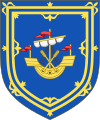 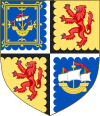 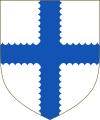 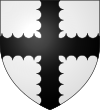
Earl of Orkney, Earl of Caithness, Lord Sinclair and Baron of Roslin Coats of Arms
|
|
| Predecessor | Henry II Sinclair, Earl of Orkney |
| Successor | William Sinclair, 2nd Earl of Caithness William Sinclair, 3rd Lord Sinclair Oliver St Clair, 12th Baron of Roslin |
| Died | c. 1480 |
| Noble family | Clan Sinclair |
| Father | Henry Sinclair, 2nd Earl of Orkney |
| Mother | Egidia Douglas |
William Sinclair (1410–1480) was an important nobleman in both Norway and Scotland. He held many titles, including the 1st Earl of Caithness, the last Earl (Jarl) of Orkney, the 2nd Lord Sinclair, and the 11th Baron of Roslin. He is also famous for building the beautiful Rosslyn Chapel in Midlothian, Scotland.
Historians sometimes call him the 1st Lord Sinclair, while others say he was the 2nd. This is because his father, Henry II Sinclair, Earl of Orkney, was the first to be officially recorded with the title of Lord Sinclair.
Contents
Early Life and Claiming Orkney
William Sinclair was the son of Henry II Sinclair, Earl of Orkney and Egidia Douglas. His mother was the daughter of Sir William Douglas of Nithsdale and the granddaughter of Robert II of Scotland. This made William part of a very important family.
William's father, Henry, who was the ruler of Orkney, passed away in 1420. In 1422, William traveled to Copenhagen to claim his right to rule Orkney. However, a man named David Menzies was chosen to govern Orkney as William's guardian until William was old enough. By 1424, William managed to take control of Orkney from his guardian. But it wasn't until 1434 that King Eric VII of Denmark, Norway, and Sweden officially recognized him as the Jarl of Orkney.
Becoming Earl of Orkney
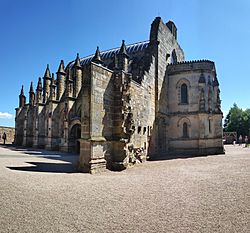
After becoming the Earl of Orkney, William quickly became involved in important Scottish affairs. In 1421, he was one of five earls chosen to be a hostage to help free James I of Scotland, who was a prisoner in England. When James I was finally released in 1423, William, Earl of Orkney, was among the important nobles who met him.
In 1423, King Eric put David Menzies in charge of the Isles again. However, there was a lot of trouble during Menzies' rule. So, the government of Orkney was given to the Bishop of Orkney for seven years. This was meant to last until William could officially take over. But William started using the title of Earl of Orkney even before his official ceremony. He was called Earl of Orkney in 1426 and again in 1428.
In 1434, William traveled to Denmark. There, King Eric officially gave him the title and power over the Earldom of Orkney. William also had to hold Kirkwall Castle for the king. In the same year, William played a big role in Scottish history. He commanded a fleet of forty-six ships that took Margaret, the daughter of James I of Scotland, to France to marry the French prince, Louis.
Building Rosslyn Chapel
In 1446, William Sinclair started building the Collegiate Church of St Matthew, which is now famously known as Rosslyn Chapel. This beautiful chapel is still a popular place to visit today.
In 1446, William was also called to the Norwegian Riksråd (a council of nobles) to swear loyalty to Christopher of Bavaria, the new king of Denmark, Norway, and Sweden. After King Christopher died in 1448, William was even considered as a possible king of Norway because he was the highest-ranking nobleman there. However, he didn't try to become king.

In 1454–55, William, Earl of Orkney, helped the Scottish king. He and the Earl of Angus led 6,000 men to attack Abercorn Castle. This was because Lord Hamilton was helping a rebel, the Earl of Douglas. Lord Hamilton was captured, and William kept him at Roslin Castle for a few days. Hamilton then decided to switch sides and support the king.
In 1460, James II of Scotland died. William, Earl of Orkney, was chosen as one of six governors to help rule Scotland while the young James III of Scotland was still a child.
Orkney Becomes Scottish
In 1468, James III of Scotland married Margaret, the daughter of Christian I of Norway, Sweden, and Denmark. King Christian couldn't pay Margaret's dowry (a payment from the bride's family). Instead, he promised to pay later and offered the territory of Orkney as a guarantee. This meant that Orkney's control shifted from Norway to Scotland.
In 1470, James III offered William the castle and lands of Ravenscraig in Fife. In exchange, William gave up his rights to Orkney and Shetland. William accepted this offer. The old Norse Earldom of Orkney still existed in name, but William now only had power over the mainland parts, Caithness and Sutherland. In 1472, it became clear that the dowry wouldn't be paid. So, King James declared that Orkney officially belonged to the Scottish Crown. This was made law by the Scottish Parliament on February 20, 1472. From then on, William ruled under the King of Scotland, not Norway.
Earl of Caithness
William traded his lordship of Nithsdale for lands in Caithness. In 1455, he was given the new title of hereditary Earl of Caithness. In 1476, he gave this Earldom to his second son from his second marriage, William.
William, Earl of Orkney, passed away before July 3, 1480.
Family Life
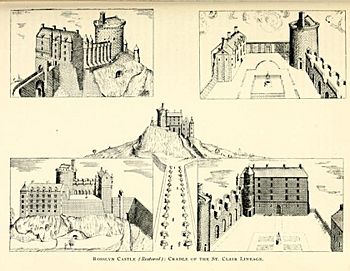
William Sinclair was married three times. His first wife was Lady Elizabeth Douglas. His second wife was Marjory Sutherland, whom he married in 1456. His third wife was Janet Yeman.
With Lady Elizabeth Douglas, he had:
- William Sinclair, 3rd Lord Sinclair, who reportedly only received Ravenscraig Castle from his father.
- Lady Catherine Sinclair, who married Alexander Stewart, Duke of Albany.
- Elizabeth Sinclair, who married Andrew, Master of Rothes.
With Marjory Sutherland, he had:
- Oliver St Clair, 12th Baron of Roslin, who received the Barony of Roslin.
- William Sinclair, 2nd Earl of Caithness (born 1460 - died 1513).
- Alexander Sinclair (around 1454).
- George Sinclair (around 1453).
- Robert Sinclair (1447).
- Arthur Sinclair (around 1452).
- Lady Eleanor Sinclair (born 1457 - died 1518), who married John Stewart, 1st Earl of Atholl.
- Lady Elizabeth Sinclair (born around 1455 - died 1498), who married the Laird of Houston.
- Lady Margaret Sinclair (around 1450), who married David Boswell of Balmuto.
- Lady Katherine Sinclair (born 1440 - died 1479).
- Lady Susan Sinclair (around 1451).
- Lady Marjory Sinclair (1455–80), who married Andrew Leslie, Master of Rothes.
- Lady Mariota Sinclair (around 1455).
- Lady Euphemia Sinclair (around 1470), who married John Kincaid Laird of Warriston.
He also had an illegitimate son:
- Sir David Sinclair of Sumburgh, who died in 1507.
William's second son from his second marriage, William Sinclair, became the next Earl of Caithness. The title of Baron of Roslin went to his first son from that marriage, Sir Oliver Sinclair.

